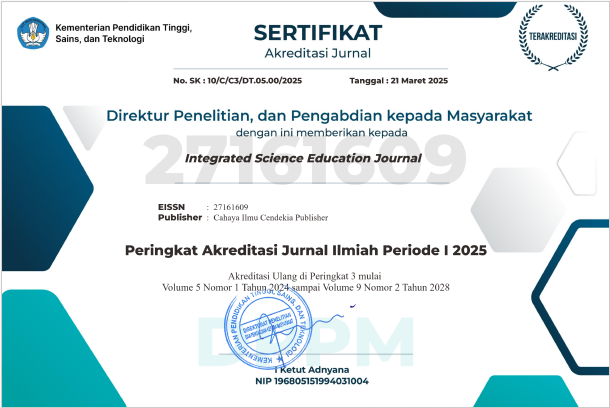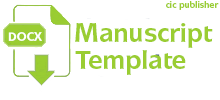Secondary School Students’ Perception of Science Laboratory Accident Status and Preventive Measures in Awka Education Zone
Abstract
Purpose of the study: The study investigated secondary school students’ assessment of science laboratory accident status and preventive measures in the Awka Education Zone. Two research questions guided the study, and one hypothesis was tested at a .05 significance level.
Methodology: The study used the descriptive survey research design. A sample of 156 public and 40 private secondary school students was used. A checklist and a questionnaire were used to collect data. The questionnaire was validated, and a Cronbach Alpha reliability test gave a coefficient of 0.86. The collected data was used to analyze mean, standard deviation, percentage, and t-tests.
Main Findings: The results revealed that science laboratory accidents do not occur in secondary schools in Awka Education Zone, irrespective of school type. The study also observed no significant difference in the preventive measures against science laboratory accidents adopted by private and public secondary school students in the zone.
Novelty/Originality of this study: There is limited literature in the present study’s area seeking to assess the laboratory accident status in secondary schools and the measures the students take to avert these accidents. Thus, the present study’s findings would provide background information on laboratory activities and accidents in the area of the research and preventive measures to be deployed.
References
C. N. Nwele, “The extent of availability of safety instruments/equipment in science laboratories in secondary schools in Ebonyi State of Nigeria,” Academic Journal of Interdisciplinary Studies, vol. 2, no. 10, pp. 131-136, 2013; 10.5901/ajis/2013.v2n10p131
T. Klaavuniemi and M. Siponen, “Demystifying beliefs about the natural sciences in information system,” Journal of Information Technology, vol. 36, no. 1, pp. 56-68, 2020; https://doi.org/10.1177/0268396220901535
E. A. Okeke, “Making science education accessible to all. 3rd Inaugural Lecture.,” in https://www.unn.edu.ng/wp-content/uploads/2015/09/23rd-INAUGURAL-LECTURE1.pdf, UNN, NSUKKA, 2007.
W. H. Al-Dahhan, A. A. Ali and E. Yousif, “Lack of Maintenance in a chemical Laboratory has almost caused an accident,” Open Access Journal of Chemistry, vol. 1, no. 1, pp. 63-66, 2017.
A. Hieronymi, “Understanding Systems Science: A Visual and IntegrativeApproach,” Systems reaserch and behavioural science, vol. 30, no. 5, pp. 580-595, 2013 https://doi.org/10.1002/sres.2215.
R. Muhammad, “Assessing the laboratory safety and security skills among science, technology and mathematics (STM) teachers in Sokoto State, Nigeria,” American Journal of Education and Learning, vol. 1, no. 2, pp. 62-68, 2017.
B. U. Mbonu & J. N. Okoli, “Effects of multimedia integrated instruction on Basic Science students’ academic achievement in Anambra state.,” in 60th annual conference proceedings of the Science Teachers Association of Nigeria (STAN), 229-237, 2019.
Y. A. Fagihi, “The level of awareness of safety measures practised in school laboratories among pre-service science teachers at Najran University,” Journal of Educational Issues, vol. 4, no. 1, pp. 107-121, 2018. doi:10.5296/jei.v4i1.12908
J. O. Babayemi and A. A. Kareem, “Services in secondary schools science laboratory as a centre for innovation in Basic Science and Technology in Akwa Ibom State, Nigeria.,” in 60th Annual Conference Proceedings of Science Teachers Association of Nigeria (STAN), Akwa Ibom, 2019.
E. C. Nwune, N. K. Oguezue and E. N. &. S. N. N. C. Okwuduba, “Knowledge and implementation of laboratory safety skills possessed by pre-service science teachers in Anambra State, Nigeria: Implications for practical science learning,” Puissant, vol. 4, no. 2, pp. 1005-1019, 2023.
K. J. Aina, “Importance of science education to national development and problems militating against its development,” American Journal of Educational Research. vol. 1, no. 7, pp. 225-229, 2013. DOI:10.12691/education-1-7-2
A. Omiko, “Laboratory teaching: Implications on students’ achievement in Chemistry in secondary schools in Ebonyi State of Nigeria,” Journal of Education and Practice, vol. 6, no. 30, pp. 206-213, 2015.
J. M. Idoko and E. A. Ibiam, “A survey of laboratory safety in secondary school in Nsukka Local Government Area,” An unpublished B.Sc(Ed) project of the Department of Science Education, University of Nigeria, Nsukka, Nsukka, 2008.
S. K. Shrivastava, “Safety Procedures in the Laboratory,” International Journal of Engineering and Scientific Research, vol. 5, no. 7, pp. 54-64, 2017; ISSN: 2229-5518.
R. B. Pareek, “An assessment of availability and utilization of laboratory facilities for teaching science at secondary level,” Science Education International, vol. 30, no. 1, 2019.
N. J. Cho, "Analysis of Safety Management Conditions and Accidents Type in Domestic and Foreign Laboratory," Journal of Ergonomics Society , vol. 35, no. 2, pp. 97-109, 2016; doi.org/10.5143/JESK.2016.35.2.97.
K. Rockwood., M. McMillan., A, Mitnitski., and S. E. Howlett, “A frailty index based on common laboratory tests in comparison with a clinical frailty index for older adults in long-term care facilities,” Journal of the American Medical Directors Association, vol. 16, no. 10, pp. 842-847, 2015.
I. O. Ikeobi, Beyond The Stereotype, Thoughts And Reflections On Education, Lagos: The CIBN Press Ltd, 2010.
C. P. &. Aydoğdu, “The opinions of the classroom teacher candidates about the causes of the accidents in the laboratories,” Journal of Education Science and Technology Research, vol. 1, no. 2, pp. 103-112, 2016.
P. A. Okebukola, A. Oladejo, F. Onowugbeda, F. Awaah, I. Ademola and T. O. &. O. A. Ajayi, “Investigating chemical safety awareness and practices in Nigerian Schools,” Journal of Chemical Education, vol. 98, no. 1, pp. 105-112, 2020. https://dx.doi.org/10.1021/acs.jchemed.0c00136
M. Ozarslan and I. Ates, “The opinions of gifted and talented students about security measures in science laboratory studies,” Journal of Educational Science, vol. 2, no. 3, pp. 42-49, 2013.
B. Caymaz, “Secondary School Students' Knowledge and Views on Laboratory Safety,” Journal of Science Learning, vol. 4, no. 3, pp. 220-229, 2021.
A. Tekbiyik and M. Tepe, “Evaluation of laboratory experiments and accidents that occurred between the years of 2001-2017 in Turkey,” International Journal of Innovative Approaches in Education, vol. 1, no. 1, pp. 11-20, 2017.
R. Artdej, “Investigating Undergraduate students' scientific understanding of laboratory safety,” Procedia Social and Behavioral Sciences, vol. 46, pp. 5058-5062, 2012.
L. D. Kalagbor, “An Analysis of Factors Influencing Students' Academic Performance in Public and Private Secondary Schools in Rivers State-Nigeria,” Journal of Education and Practice, vol. 7, no. 28, pp. 96-101, 2016.
V. Baburajan, J. A. Silva and F. C. Pereira, “Open vs Close-ended questions in attitudinal surveys - comparing, combining, and interpreting using natural languge processing,” Transportation Research Part C: Emerging Technologies, vol. 137, 2022; https://doi.org/10.1016/j.trc.2022.103589.
S. Akpullukcu and B. Cavas, “The development of a laboratory safety questionnaire for middle school science teachers,” Science Education International, vol. 28, no. 3, pp. 224-231, 2017. https://doi.org/10.33828/sei.v28.i3.6
P. M. Nardi, Doing Survey Research: A Guide To Quantitative Methods., Routledge, 2018.
L. Mack, “The philosophical underpinnings of educational research,” Polyglossia, vol. 19, pp. 5-11, 2007.
J. W. Creswell, “Mapping the field of mixed methods research,” Journal of Mixed Methods Research, vol. 3, no. 2, pp. 95-108, 2009.
C. Aydoğdu & E. Yardımcı, “Accidents that occur in primary education science laboratories and behaviours that teachers can develop,” Hacettepe University Journal of Education Faculty, vol. 44, pp. 52-60, 2013.
Copyright (c) 2023 Emmanuel Chibuike Nwune, Nnaemeka Kenechi Oguezue, Blessing Ifeoma Odum

This work is licensed under a Creative Commons Attribution-NonCommercial 4.0 International License.
Authors who publish with this journal agree to the following terms:
- Authors retain copyright and acknowledge that the Integrated Science Education Journal is the first publisher licensed under a Creative Commons Attribution 4.0 International License.
- Authors are able to enter into separate, additional contractual arrangements for the non-exclusive distribution of the journal's published version of the work (e.g., post it to an institutional repository or publish it in a book), with an acknowledgment of its initial publication in this journal.
- Authors are permitted and encouraged to post their work online (e.g., in institutional repositories or on their website) prior to and during the submission process, as it can lead to productive exchanges and earlier and greater citation of published work.







.png)
.png)






